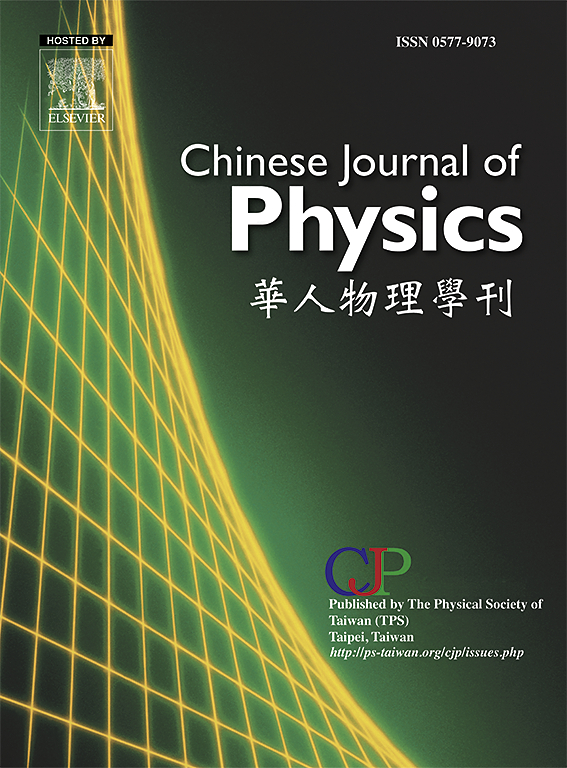An analytical exploration of low Reynolds number cilia-driven flow of Johnson-Segalman fluid with heat transfer effects
IF 4.6
2区 物理与天体物理
Q1 PHYSICS, MULTIDISCIPLINARY
引用次数: 0
Abstract
This article discusses the properties of heat transfer on Johnson-Segalman fluids in a complex wavy channel made of metachronal wavy cilia. Such complex wall structures can be used in the design of biomimetic systems. The movement of fluid through a two-dimensional complex wave channel produced by the metachronal wave of cilia is characterized as laminar and incompressible. Firstly, the system of equations is transformed from a fixed frame of reference to a wavy frame of reference. Secondly, the system of equations of motion (EOM) is transformed into a non-dimensional form by using the scaling factors. Mathematical analysis has been conducted using long wavelength as well as low Reynold numbers assumptions. The perturbation approach is used to solve the simplified governing equations for the axial velocity, temperature, stream function, pressure rise, and heat transfer coefficients. The equations representing axial velocity, pressure rise, and the streaming function are illustrated, and the reason for observed changes in different physical aspects are explained using basic theoretical principles. A solution for small values of the Weissenberg numbers is generated for the resulting nonlinear system. The current study investigates the effects of different boundaries and rheology on fluid flow.
The velocity profile increases near the channel center with higher Q (time-mean flow rate) and (slip parameter), but decreases with greater Weissenberg number (We). The Brinkman number (Br), Q, and directly influence the temperature distribution, while we have the opposite effect. The size and number of trapped boluses increase with higher Q but decrease with rising We and . It is noteworthy that the overall number of trapped zones rises throughout the complex wavy path.

低雷诺数纤毛驱动的约翰逊-塞格曼流体流动与传热效应的分析探索
本文讨论了约翰逊-塞格曼流体在由元纤毛组成的复杂波浪形通道中的传热特性。这种复杂的壁结构可用于仿生物系统的设计。流体在由纤毛元波浪产生的二维复杂波浪通道中的运动具有层流和不可压缩的特点。首先,将方程系统从固定参照系转换为波浪参照系。其次,利用缩放因子将运动方程(EOM)系统转换为非维度形式。数学分析采用了长波长和低雷诺数假设。采用扰动法求解轴向速度、温度、流函数、压升和传热系数的简化控制方程。图解了代表轴向速度、压力上升和流函数的方程,并利用基本理论原理解释了观察到的不同物理方面变化的原因。对由此产生的非线性系统生成了魏森堡数小值的解决方案。当前的研究调查了不同边界和流变对流体流动的影响。Q(时间平均流速)和 e¯(滑移参数)越高,通道中心附近的速度曲线越大,但魏森堡数(We)越大,速度曲线越小。布林克曼数(Br)、Q 和 e¯ 直接影响温度分布,而 We 的影响则相反。Q 越大,被捕获的栓子的大小和数量越多,但 We 和 e¯ 越大,被捕获的栓子的大小和数量越少。值得注意的是,在整个复杂的波浪形路径中,截留区的总数都在上升。
本文章由计算机程序翻译,如有差异,请以英文原文为准。
求助全文
约1分钟内获得全文
求助全文
来源期刊

Chinese Journal of Physics
物理-物理:综合
CiteScore
8.50
自引率
10.00%
发文量
361
审稿时长
44 days
期刊介绍:
The Chinese Journal of Physics publishes important advances in various branches in physics, including statistical and biophysical physics, condensed matter physics, atomic/molecular physics, optics, particle physics and nuclear physics.
The editors welcome manuscripts on:
-General Physics: Statistical and Quantum Mechanics, etc.-
Gravitation and Astrophysics-
Elementary Particles and Fields-
Nuclear Physics-
Atomic, Molecular, and Optical Physics-
Quantum Information and Quantum Computation-
Fluid Dynamics, Nonlinear Dynamics, Chaos, and Complex Networks-
Plasma and Beam Physics-
Condensed Matter: Structure, etc.-
Condensed Matter: Electronic Properties, etc.-
Polymer, Soft Matter, Biological, and Interdisciplinary Physics.
CJP publishes regular research papers, feature articles and review papers.
 求助内容:
求助内容: 应助结果提醒方式:
应助结果提醒方式:


